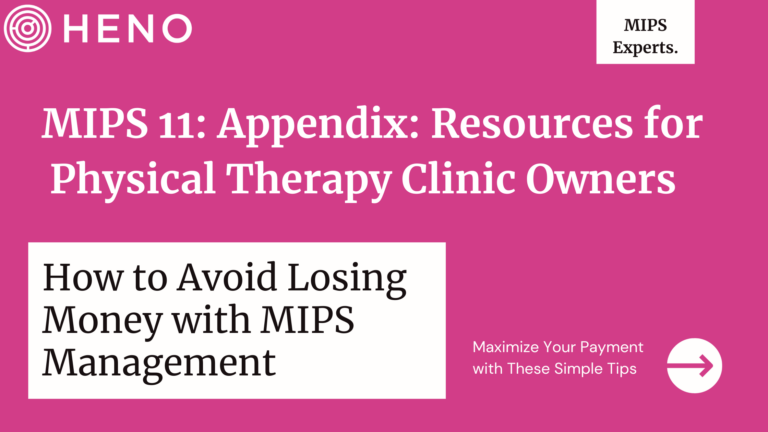MIPS 9: MIPS Compliance and Audits

In this article we’ll explore MIPS Compliance and Audits. If you haven’t already read the first 3 articles in this series, you can click the following to read them, and if you need the MIPS Quick start guide from Medicare you can get that here.
MIPS Compliance Checklist for Physical Therapy Clinic Owners
Introduction:
As a physical therapy clinic owner, you understand the importance of providing high-quality care to your patients. However, with the introduction of the Merit-Based Incentive Payment System (MIPS), it has become crucial for clinic owners to also focus on meeting the compliance requirements set forth by the Centers for Medicare and Medicaid Services (CMS). This subchapter will provide you with a comprehensive MIPS compliance checklist specifically tailored for physical therapy clinics.
1. Understanding MIPS:
Begin by familiarizing yourself with the MIPS program and its requirements. This includes understanding the four performance categories: Quality, Promoting Interoperability, Improvement Activities, and Cost. Stay up-to-date on MIPS reporting requirements, as they may change from year to year.
2. Assessing Eligibility:
Determine if your clinic is eligible to participate in MIPS. The eligibility criteria are based on the number of Medicare Part B patients seen and the total allowed charges for covered professional services. Ensure that you meet the threshold requirements to avoid penalties.
3. Quality Measures:
Identify the quality measures applicable to physical therapy clinics. Select measures that align with your clinic’s focus and patient population. Establish a process for collecting and reporting data on these measures accurately.
4. Promoting Interoperability:
Understand the Promoting Interoperability category, which emphasizes the use of certified electronic health record (EHR) technology. Ensure that your clinic’s EHR system meets the required standards and incorporates functionalities needed for reporting.
5. Improvement Activities:
Explore the improvement activities that address care coordination, beneficiary engagement, and patient safety. Select activities that align with your clinic’s goals and implement them effectively. Document your efforts and keep records for reporting purposes.
6. Cost Category:
Be aware of cost measures that relate to physical therapy services. Monitor the cost of care provided to patients and identify opportunities for improvement. Work on optimizing resource utilization while maintaining high-quality care standards.
7. Reporting and Submission:
Create a plan for reporting and submitting MIPS data to CMS. Determine the reporting method that suits your clinic, whether it’s through a qualified registry, EHR vendor, or directly through the CMS web interface. Ensure timely submission to avoid penalties.
Conclusion:
By following this MIPS compliance checklist, physical therapy clinic owners can navigate the complexities of the program effectively. Meeting MIPS requirements not only helps you avoid penalties but also positions your clinic for potential incentives and improves the overall quality of care provided to your patients. Stay informed, stay compliant, and continue to deliver exceptional physical therapy services while maximizing your clinic’s performance under MIPS.
Preparing for MIPS Audits
As a physical therapy clinic owner, understanding and effectively participating in the Merit-Based Incentive Payment System (MIPS) is crucial for the success of your clinic. MIPS is a program that measures and rewards healthcare providers based on the quality of care they deliver. It aims to improve patient outcomes, promote efficiency, and enhance the overall quality of healthcare services.
However, participating in MIPS also means being subject to audits by the Centers for Medicare and Medicaid Services (CMS) to ensure compliance with program requirements. To help you navigate the audit process successfully, this chapter will provide you with a comprehensive guide on preparing for MIPS audits.
The first step in preparing for MIPS audits is to ensure that your clinic is maintaining accurate and complete documentation. This includes patient records, billing documents, and any other relevant documentation that supports the services provided. It is essential to have a robust documentation system in place to track and record all patient encounters, treatments, and outcomes.
Next, you should familiarize yourself with the specific MIPS requirements for physical therapy clinics. Understanding the program’s quality measures, reporting criteria, and documentation requirements will help you proactively address any potential issues before they become audit concerns. Stay up-to-date with CMS guidelines and attend webinars or training sessions to ensure you have the most current information.
Regularly monitor and evaluate your clinic’s performance in meeting MIPS requirements. Implementing internal audits can help identify any areas of non-compliance or documentation gaps. Addressing these issues promptly will not only improve your clinic’s overall performance but also minimize the risk of audit penalties.
Consider working with a MIPS consultant or hiring a qualified professional to conduct an external audit of your clinic’s MIPS compliance. They can provide an objective assessment of your clinic’s performance, identify any potential areas of concern, and offer recommendations for improvement.
Develop a comprehensive compliance plan that includes policies and procedures for meeting MIPS requirements. Educate your staff on the importance of accurate documentation and MIPS compliance, and provide ongoing training to ensure everyone is well-informed and updated on the latest program changes.
Finally, establish a system for maintaining and archiving all MIPS-related documentation. This will make it easier to retrieve and present the necessary information in the event of an audit.
By following these guidelines and preparing for MIPS audits proactively, you can ensure that your physical therapy clinic remains compliant with program requirements, avoids penalties, and continues to provide high-quality care to your patients.
Responding to Audit Findings
As a Physical Therapy Clinic Owner, it is crucial to be well-versed in the Medicare Access and CHIP Reauthorization Act (MACRA) and the Merit-Based Incentive Payment System (MIPS) regulations. Understanding how to respond to audit findings is an essential aspect of ensuring compliance and maximizing your clinic’s reimbursement potential.
When it comes to responding to audit findings in the context of MIPS for Physical Therapy Clinics, there are a few key steps you should follow:
1. Review the audit findings: Carefully examine the audit report to understand the specific areas where your clinic may have fallen short of compliance. This could include documentation deficiencies, inaccurate reporting, or failure to meet performance thresholds.
2. Identify areas for improvement: Once you have identified the audit findings, determine the root causes and areas where improvements can be made. This could involve enhancing your documentation practices, implementing better processes for data collection and reporting, or providing additional training to your staff.
3. Develop an action plan: Based on the identified areas for improvement, create a detailed action plan that outlines the necessary steps to address the audit findings. This plan should include specific timelines, responsible individuals, and measurable goals to track progress.
4. Implement corrective measures: Execute the action plan by implementing the necessary changes and improvements within your clinic. This may involve updating documentation templates, conducting staff training sessions, or adopting new technologies to streamline data collection and reporting.
5. Monitor and evaluate progress: Continuously monitor and evaluate the effectiveness of the corrective measures implemented. Regularly review performance data, conduct internal audits, and seek feedback from staff to ensure sustained compliance and ongoing improvement.
6. Seek professional guidance if needed: If you find yourself overwhelmed or unsure about how to respond to audit findings, consider seeking professional guidance. There are healthcare consultants and experts who specialize in MIPS for Physical Therapy Clinics and can provide valuable insights and support.
By responding effectively to audit findings, you can reduce the risk of penalties, optimize your reimbursement, and ensure the long-term success of your Physical Therapy Clinic. Remember, compliance is an ongoing process, and staying proactive in addressing audit findings is key to maintaining a thriving clinic in the ever-evolving healthcare landscape.





